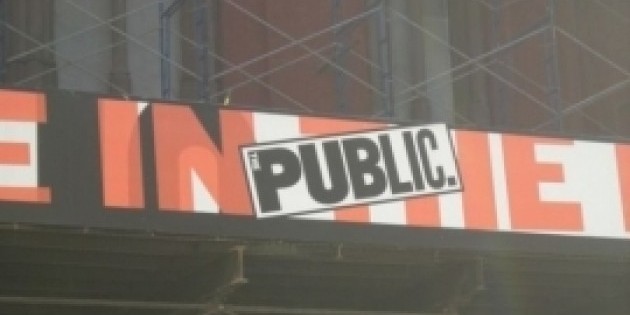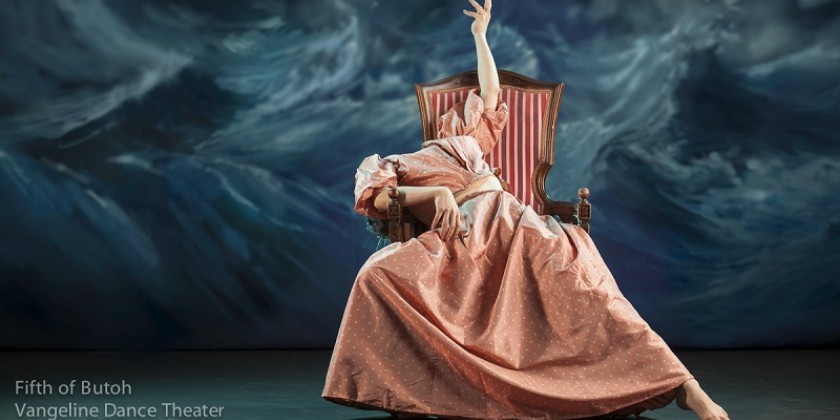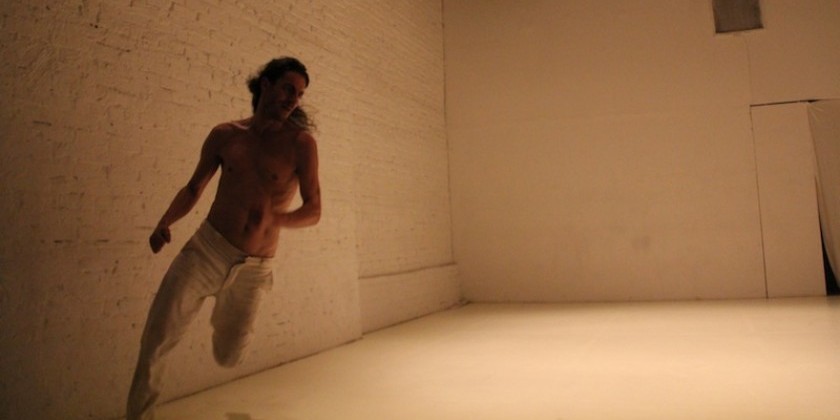IMPRESSIONS: Martha Graham Company and SITI Company's Work in Progress

Showings of American Document - January 6th 2010
Inspired by Martha Graham’s 1938 dance American Document
Directed by Ann Bogart
Created and Performed by Martha Graham Dance Company and SITI Company
Impressions by:
| Cory Nakasue
When I think of Martha Graham, I think of—well--prairies, and for some reason, the music of John Williams, and bonnets. I think of these words: pioneer, individual, and prairie, yet again. |
Phoebe Silva Theater Enthusiast and Guest Writer In the latter half of American Document, a re-envisioning of Martha Graham’s 1938 dance/performance piece, the Interlocutor, our guide for the evening, asks each member of the company, comprised of members from both the Martha Graham Dance Company and SITI Company: “What is an American?” The seemingly cliché question receives a beautifully symbolic answer when the company members, representing half a dozen different countries of origin, respond individually in their native tongues. |
Liz Sklar Theater Enthusiast and Guest Writer The Map |
© Cory Nakasue 2010
Martha Remixed
As American as the Constitution.
As American as Martha Graham.
When I think of Martha Graham, I think of—well--prairies, and for some reason, the music of John Williams, and bonnets. I think of these words: pioneer, individual, and prairie, yet again.
I have read more about the woman and studied her dance techniques more than I have experienced the actual performances of the work. And yet, you say “Graham” to me, and I have a very distinct visceral response: running o’er hill and dale with my little cupped “Graham hands” and then stopping in some dramatic convulsion and falling to the floor, only to rise again, railing against conformity and asserting my power to all oppressors.
The mythology of Martha Graham and her dances have such a powerful narrative that the woman and her work have become iconic, and in certain circles the woman and her work are not to be fooled with.
Enter Chuck Mee and Anne Bogart.
Would it be irreverent or disrespectful to call him “Mix Master Chuck?” Okay, probably. But when I read or see a Charles Mee play, I imagine him as a DJ in a club sampling some poetry, fictionalizing a court document, mixing it with some “found” pieces of conversation and creating new text out of some old texts we’ve taken for granted—AND getting an audience to appreciate, maybe even love these pieces again.
It takes a certain amount irreverence to do this, but to do it well takes a lot of respect for whatever materials you’re working with.
The original libretto for Martha Graham’s American Document, created in 1938, was compiled in much the same way, using excerpts of Walt Whitman, The Declaration of Independence and many other documents and pieces of writing she felt would be useful in her effort to define what it means to be an American. Chuck Mee continues this line of questioning, mixing in a wild array of his own findings and creations—everything from Jack Kerouac, to Abbot and Costello, to what seemed like extrapolations from John Yoo’s memos on “enhanced interrogation techniques.”
SITI Company actors and Martha Graham Company dancers intermingle through the “80% finished” work. The dancers speak, the actors do Graham choreography, the tension between the disciplines is present but unremarkable. What is remarkable is the cohesive vision they were able to achieve, not just throughout this performance of the piece, but the cohesion they were able to maintain with Graham’s original work.
Graham’s choreography was not spared the remix and pastiche treatment, but lovingly done, and presented in a way that shattered the glass case it’s usually kept in. There is such devotion to the history and tradition of Martha Graham, as is deserved, but placing the choreography in formaldehyde doesn’t honor the spirit and brilliance of the daring woman who took huge risks.
The original American Document questioned America at a time when we weren’t supposed to be asking questions about America. It was a time when we were supposed to huddle tightly together and respect those documents in the glass case. This new production of American Document comes to us after we’ve seen the results of blind reverence for tradition and blind faith in our own narratives and mythologies as a nation. It asks us to and shows us how to mine the materials at our disposal.
Ask questions, and find what’s relevant to the people we have become.
Discard. Remix. Do over?
I look forward to seeing the completed work at the Joyce in June.
© Phoebe Silva-Theater Enthusiast and Guest Writer
In the latter half of American Document, a re-envisioning of Martha Graham’s 1938 dance/performance piece, the Interlocutor, our guide for the evening, asks each member of the company, comprised of members from both the Martha Graham Dance Company and SITI Company: “What is an American?” The seemingly cliché question receives a beautifully symbolic answer when the company members, representing half a dozen different countries of origin, respond individually in their native tongues.
When the question is posed to two native-born artists, they look at each other and break into simultaneous, iconic Graham choreography, recognizable even to a dance neophyte like myself. In this revelatory moment, the role of modern dance in America’s cultural fabric vividly comes to fruition, as a moving, living piece of American history. It is as if the cultural and historical relevance of Graham’s work is being written before our very eyes, by the act of being quoted.
American Document is a fascinating collision of modern dance, text both found and original, and music-- all iconic, and all American. Directed by SITI Company’s Artistic Director Anne Bogart, and textually adapted by playwright and SITI member Charles Mee. This work-in-progress weaves a broadly poetic and patriotic tapestry of 20th century American culture.
As I understand, the process by which the piece was (and is still being) developed is an interesting departure from the way the Graham Company usually works, although it was somewhat familiar to me, coming to the show as an avid SITI Company fan.
Ordinarily, the Martha Graham Dance Company is a repertory company, resurrecting and thereby continually creating living documentation of Graham’s legendary body of work. To take iconic choreography and break it into pieces, toss the pieces into a hat with a number of other artistic elements, and then pull them out and assemble them in an entirely new order, just isn’t done in the classical dance world. As Janet Eilber, Artistic Director of the Graham Company stated in her introduction to the opening night performance, dance, particularly modern dance, is simply a much younger art form than text or theater.
Nobody messes with modern dance the way they mess with Shakespeare, lifting it from its Elizabethan roots and placing it into all kinds of crazy contexts, even cutting and pasting the words themselves.
As the audience was given a brief introduction to the history of the piece, aided by large projections of Graham’s nearly-illegible notes on American Document, her fragmented original libretto for the piece, with stills and short movie clips (the only existing documentation), it suddenly became clear just how appropriate a subject for experimentation this particular piece was. Graham’s original script was almost entirely composed of found text taken from iconic literary sources. The original text for the piece was already an experiment, a vehicle for exploring the ever relevant, ever evolving question of what it means to be an American. Could this piece continue to develop, a piece that is always evolving, adapting to include each new piece of our cultural history as it comes to pass? What an exciting concept!
In her introduction to the piece, Anne Bogart spoke about the American tendency to focus on the product rather than the process. SITI Company’s work has always thrilled me for that very reason: here is a company of theater artists who are working with the very old-world ideal of process, above all else. Although they do present fully conceived, staged and designed productions, they frequently revisit their past work months or even years down the line, and in doing so have managed to create an imaginative, malleable body of work, ever deepening in its artistic inquiries. It’s an exciting approach to bring to the work of Martha Graham, whose incredibly precise style could seem to resist variation in a contemporary context.
All of the elements at work in the piece are a little mind-blowing: Mee has created a collage of a script, based on Graham’s original script, which itself was essentially a collage of American documents. And the sampled texts, which clearly were iconic in 1938, have only become more so over the past 60 years. It’s a fitting task for Mee, to reign in these texts, organize and utilize them: many of his plays feature found text and characters from various historical and mythical sources. This kind of source sampling can be a powerful theatrical tool, creating an instant, emotional and often nostalgic connection between the audience and the text.
The bare playing space is constantly being transformed, and as each quotation—be it literary, musical, or movement—washes away the last, my imagination becomes so stimulated that I begin to see cultural references in the cracks between references.
Fragments of scenes of small town, developing America pepper the piece: one moment the performers are moving or dancing through the space in what seems like abstract stage movement, and then in an instant, cued by a train whistle or a drum beat, they’ll pause, and suddenly we’re glimpsing at immigrants in Brooklyn, or witnessing a bustling square in Oklahoma. A stunning pas-de-deux danced to a low, slow, sweaty jazz tune in the background stirred an image of Stella and Stanley of “A Streetcar Named Desire” clinging to each other in the New Orleans heat. A section about torture and war evokes every terror from World War II to 9/11 without referencing any specific event.
The choreography creates a vibrant, evocative frame for questions of national identity, particularly when put onto the bodies of the SITI actors. When the actors put Graham’s choreography onto their bodies, the movements come alive in revelatory ways. One particularly interesting sequence features Leon Ingulsrud, a SITI actor, reciting an excerpt by Jack Kerouac while moving through a sequence of Graham choreography. As he dances, he is being scrutinized, coached, and corrected by Principal Graham dancer, Tadej Brdnik. It is a feat of immense concentration, ironically, taking place during a speech about hitchhiking.
So what is an American after all? What does he look like? Is he an immigrant? Is he most concerned with autonomy, above all else? Or does he long for community? Is he always in pursuit of upholding ideals of freedom, democracy and equality? And what does it mean to be an American artist?
Shouldn’t great art always leave you with more questions than you arrived with?
© Liz Sklar- Theater Enthusiast and Guest Writer
After a week’s reflection on American Document, I am intrigued by the images that remain:
The Map
The Core
The Hands
War
“Who’s on First?”
Story
The Suitcase
Main Street
Foreigners
Rats
Hope
Anger
Actors
Dancers
Humor
Horror
“What is an American?”
What the performers left behind in me, I notice, is a list of conflicting images and America is at its root a contradiction. That is what makes it so compelling.
To be one thing and something else at the same time.
To be a Martha Graham piece and also a work in progress.
To be a dance piece and a piece of theater.
To be a foreigner and an American.
To move the hands, the extremities, but maintain a strong solid center.
Just as the performance was a work in progress, so is America.
I am eager to see how the performance continues to evolve and hope that when June arrives, the piece is not presented as a final statement, but a deeper exploration.












